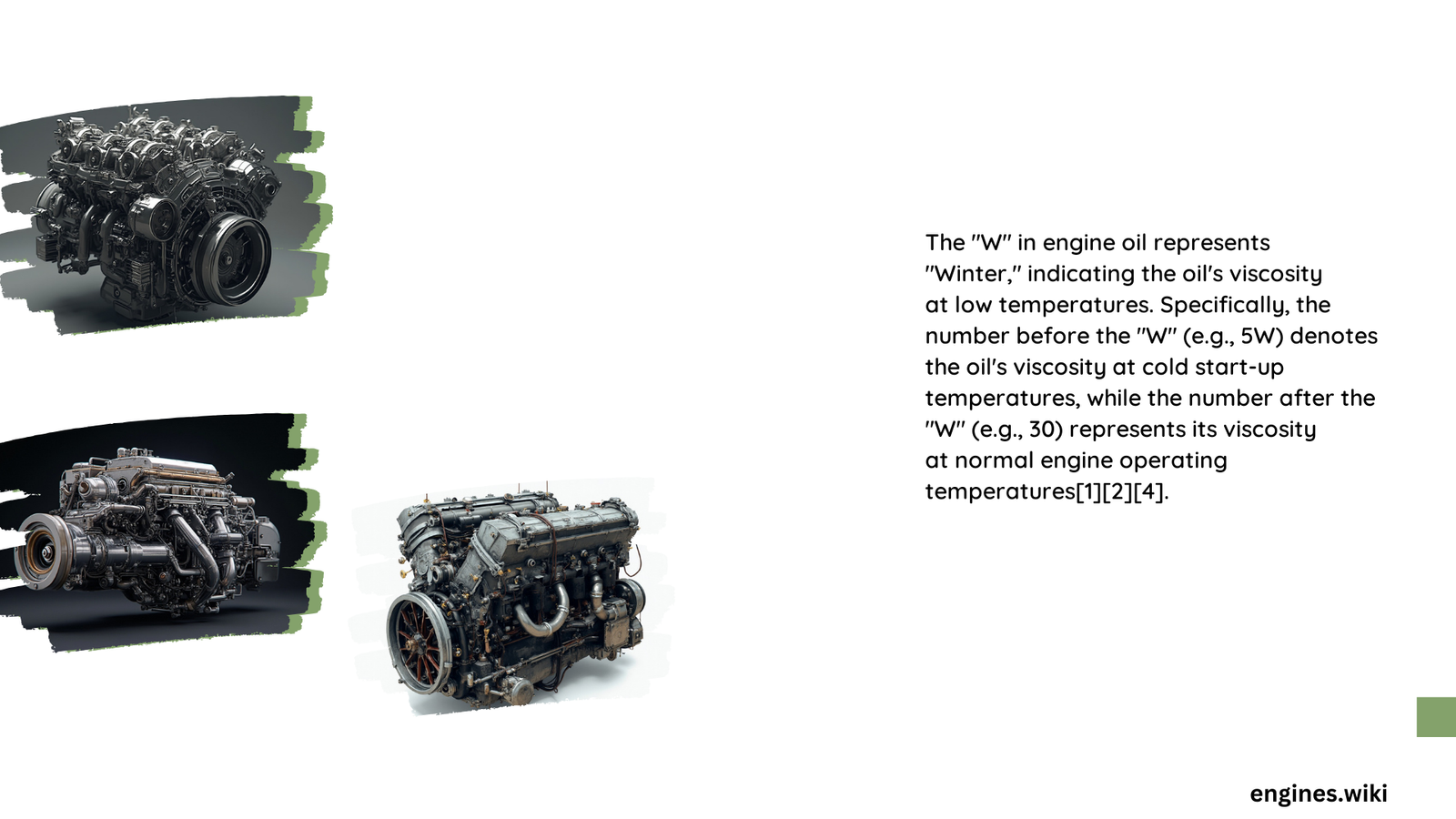The ‘W’ in engine oil represents the oil’s winter viscosity rating, a crucial factor in determining its performance in cold temperatures. This rating system, developed by the Society of Automotive Engineers (SAE), helps consumers choose the right oil for their vehicles, especially in colder climates. Understanding the ‘W’ rating is essential for proper engine maintenance and optimal performance across various temperature ranges.
What Does the ‘W’ in Engine Oil Actually Stand For?
The ‘W’ in engine oil stands for ‘Winter.’ It indicates the oil’s ability to flow at low temperatures, which is critical for cold engine starts. For example, in a 5W-30 oil:
- The ‘5W’ represents the oil’s winter viscosity rating
- The ’30’ indicates its viscosity at normal operating temperatures
This dual-number system allows for multi-grade oils that perform well in both cold and warm conditions.
How Does the ‘W’ Rating Affect Engine Performance in Cold Weather?

The ‘W’ rating directly impacts an engine’s cold-start performance:
- Lower ‘W’ numbers (e.g., 0W, 5W) indicate better cold-weather performance
- Higher ‘W’ numbers (e.g., 10W, 15W) may struggle in extremely cold conditions
A lower ‘W’ rating means:
– Easier engine starts in cold weather
– Quicker oil circulation upon startup
– Better protection against wear during cold starts
What Are the Specific Viscosity Measurements for Different ‘W’ Ratings?
The SAE J300 standard defines viscosity requirements for each ‘W’ grade:
| ‘W’ Grade | Max. Low-Temperature Cranking Viscosity (cP) | Max. Low-Temperature Pumping Viscosity (cP) |
|---|---|---|
| 0W | 6,200 at -35°C | 60,000 at -40°C |
| 5W | 6,600 at -30°C | 60,000 at -35°C |
| 10W | 7,000 at -25°C | 60,000 at -30°C |
| 15W | 7,000 at -20°C | 60,000 at -25°C |
| 20W | 9,500 at -15°C | 60,000 at -20°C |
| 25W | 13,000 at -10°C | 60,000 at -15°C |
These measurements ensure that oils with specific ‘W’ ratings will perform as expected in cold conditions.
Why Do Multi-Viscosity Oils Use the ‘W’ Rating System?
Multi-viscosity oils use the ‘W’ rating system to provide:
- Effective cold-start protection
- Adequate lubrication at normal operating temperatures
- Versatility across a wide temperature range
This system allows for:
– Easier engine starts in winter
– Proper oil flow and protection when the engine is hot
– Reduced need for seasonal oil changes in many climates
How Does the ‘W’ Rating Influence Oil Selection for Different Climates?
The ‘W’ rating is crucial when selecting oil for specific climates:
- For extremely cold regions: Choose lower ‘W’ ratings (0W, 5W)
- For moderate climates: Mid-range ‘W’ ratings (10W) may suffice
- For warmer regions: Higher ‘W’ ratings (15W, 20W) might be acceptable
Factors to consider:
– Lowest expected temperatures in your area
– Vehicle manufacturer recommendations
– Driving habits and conditions
What Are the Benefits of Using Low ‘W’ Rated Oils in Modern Engines?
Modern engines often benefit from low ‘W’ rated oils:
- Improved fuel efficiency due to reduced internal friction
- Faster engine warm-up times
- Better cold-start protection, especially in hybrid or start-stop systems
However, always consult your vehicle’s manual for the recommended oil viscosity.
How Has the ‘W’ Rating System Evolved with Advancements in Oil Technology?
The ‘W’ rating system has evolved alongside oil technology:
- Introduction of synthetic base oils allowed for lower ‘W’ ratings
- Development of more stable viscosity modifiers improved multi-grade performance
- New additive technologies enhanced cold-flow properties
This evolution has led to:
– Oils with extremely low ‘W’ ratings (e.g., 0W-16, 0W-20)
– Extended oil change intervals
– Improved overall engine protection and efficiency
What Are the Potential Drawbacks of Using Oils with Very Low ‘W’ Ratings?
While low ‘W’ rated oils offer benefits, there are potential drawbacks:
- May not provide adequate protection in extremely high temperatures
- Can be more expensive than higher ‘W’ rated oils
- May not be suitable for older engine designs
Considerations:
– Always follow manufacturer recommendations
– Consider your specific driving conditions and climate
– Balance cold-start performance with high-temperature protection
How Do Oil Manufacturers Achieve Low ‘W’ Ratings in Their Formulations?
Oil manufacturers achieve low ‘W’ ratings through:
- Use of high-quality synthetic base oils
- Advanced pour point depressants
- Carefully engineered viscosity modifiers
These technologies allow oils to:
– Flow easily at very low temperatures
– Maintain proper viscosity across a wide temperature range
– Provide consistent protection in various operating conditions
Understanding the ‘W’ in engine oil ratings is crucial for proper vehicle maintenance and performance. By selecting the appropriate oil viscosity for your climate and driving conditions, you can ensure optimal engine protection and efficiency throughout the year.
References:
1. USLube – What Does 5W-30 Mean? Engine Oil Grades Explained
2. Castrol USA – OIL VISCOSCITY AND MOTOR OIL GRADES
3. Castrol USA – MOTOR OIL VISCOSITY GRADES
